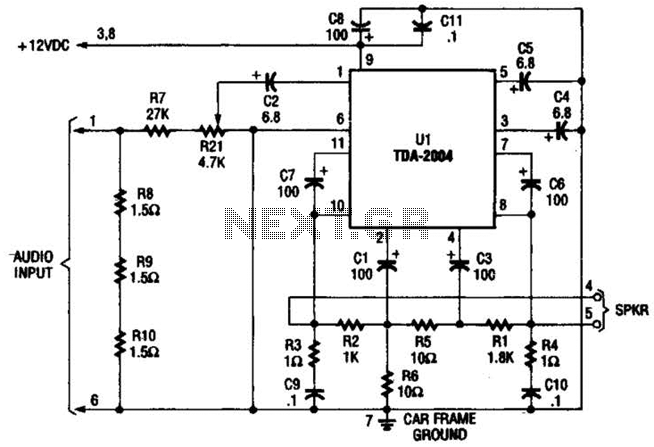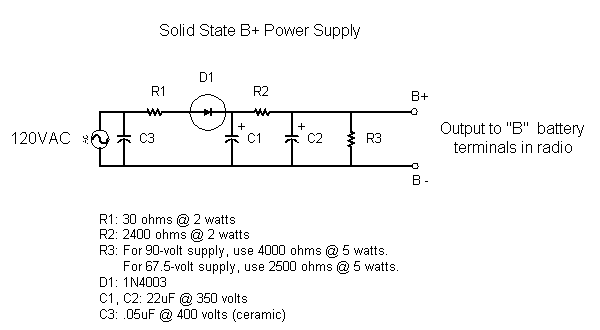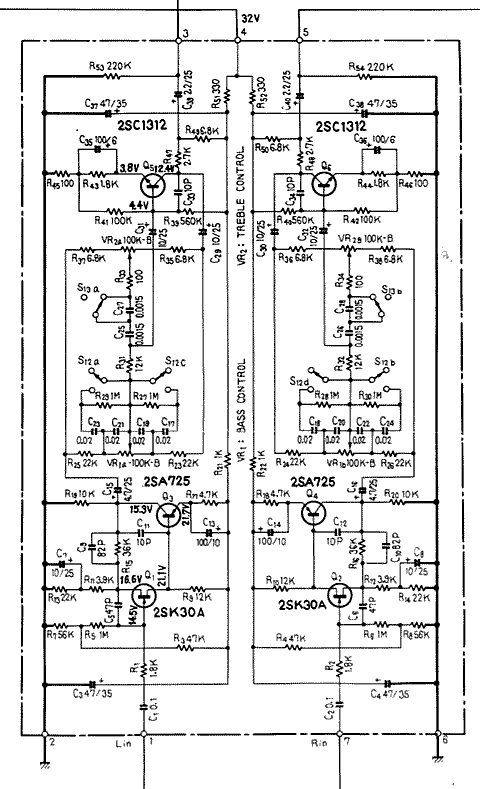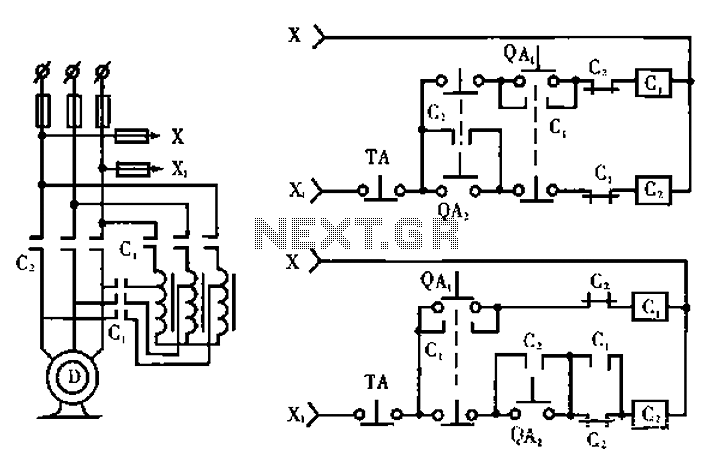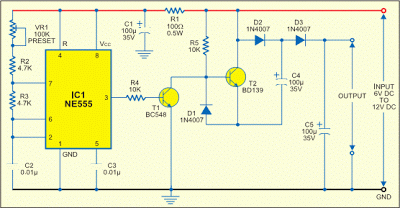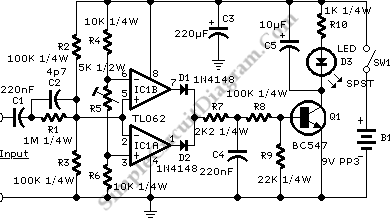
45 Watt Class-B Audio Power Amplifier
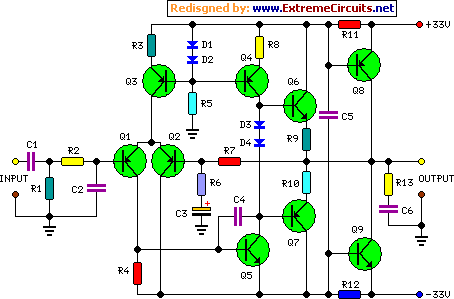
The goals were achieved by utilizing a discrete-component operational amplifier (op-amp) driving a bipolar junction transistor (BJT) complementary common-emitter output stage configured for Class B operation. In this configuration, the output transistors remain off for small output currents, allowing the op-amp to supply the entire output current. As output currents increase, the power transistors become active, limiting the op-amp's contribution to approximately 0.7/R11. The quiescent current of the op-amp biases the external transistors, significantly reducing crossover distortion. This concept originated from a letter published in Wireless World, December 1982, by N. M. Allinson from the University of Keele, Staffordshire. The letter discussed the use of op-amp integrated circuits as drivers, but due to the requirement for supply voltages of up to ±35V for a 50W amplifier, a discrete-component op-amp was considered, which proved to be a beneficial choice. The discrete-component op-amp is based on a design by Douglas Self, although his original circuit featured a Class A output stage. For optimal performance of this amplifier, a Class B output stage op-amp was necessary, leading to modifications of the original circuit. By employing a mains transformer with a secondary winding rated at the standard value of 25 + 25V (or 24 + 24V) and a power rating of 100/120VA, two amplifiers can be driven to output powers of 45W and 69W into 8 and 4 Ohms, respectively, while maintaining very low distortion levels (less than 0.01% at 1kHz and 20W into 8 Ohms). This straightforward yet robust circuit, designed for high-quality audio applications and to complement a series of articles on the Modular Preamplifier Control Center, is also well-suited for creating an excellent guitar or bass amplifier.
The described circuit utilizes a discrete operational amplifier designed to drive a complementary BJT output stage configured for Class B operation. The use of discrete components allows for higher voltage ratings and customization of the amplifier's characteristics, which is particularly advantageous for high-power audio applications.
In the circuit, the op-amp operates in conjunction with the output transistors to manage the current flow effectively. For low output currents, the op-amp is responsible for supplying the output current entirely, thus avoiding the inefficiencies associated with the output transistors. As the output current requirement increases, the output transistors begin to conduct, taking over the output current supply while the op-amp contributes minimally, as defined by the formula 0.7/R11. This design choice minimizes crossover distortion, a common issue in amplifiers, by ensuring that the quiescent current from the op-amp keeps the external transistors biased adequately.
The transformer specifications of 25 + 25V or 24 + 24V with a power rating of 100/120VA are critical for providing the necessary power to achieve the desired output levels of 45W into 8 Ohms and 69W into 4 Ohms. The design emphasizes low distortion, ensuring that audio signals remain clear and accurate, even at higher power levels.
This amplifier circuit is versatile and can be applied in various audio applications, including as a high-fidelity audio amplifier or as a dedicated guitar or bass amplifier. Its rugged construction and straightforward design make it suitable for both professional and amateur audio environments, enhancing the overall audio experience.These goals were achieved by using a discrete-components op-amp driving a BJT complementary common-emitter output stage into Class B operation. In this way, for small output currents, the output transistors are turned off, and the op-amp provides all of the output current.
At higher output currents, the power transistors conduct, and the contribution of the op-amp is limited to approximately 0. 7/R11. The quiescent current of the op-amp biases the external transistors, and hence greatly reduces the range of crossover. The idea sprang up from a letter published on Wireless World, December 1982, page 65 written by N. M. Allinson, then at the University of Keele, Staffordshire. In this letter, op-amp ICs were intended as drivers but, as supply voltages up to +/- 35V are required for an amplifier of about 50W, the use of an op-amp made of discrete-components was then considered and the choice proved rewarding.
The discrete-components op-amp is based on a Douglas Self design. Nevertheless, his circuit featured quite obviously a Class A output stage. As for proper operation of this amplifier a Class B output stage op-amp is required, the original circuit was modified accordingly. Using a mains transformer with a secondary winding rated at the common value of 25 + 25V (or 24 + 24V) and 100/120VA power, two amplifiers can be driven at 45W and 69W output power into 8 and 4 Ohms respectively, with very low distortion (less than 0.
01% @ 1kHz and 20W into 8 Ohms). This simple, straightforward but rugged circuit, though intended for any high quality audio application and, above all, to complete the recently started series of articles forming the Modular Preamplifier Control Center, is also well suited to make a very good Guitar or Bass amplifier. Enjoy! 🔗 External reference
The described circuit utilizes a discrete operational amplifier designed to drive a complementary BJT output stage configured for Class B operation. The use of discrete components allows for higher voltage ratings and customization of the amplifier's characteristics, which is particularly advantageous for high-power audio applications.
In the circuit, the op-amp operates in conjunction with the output transistors to manage the current flow effectively. For low output currents, the op-amp is responsible for supplying the output current entirely, thus avoiding the inefficiencies associated with the output transistors. As the output current requirement increases, the output transistors begin to conduct, taking over the output current supply while the op-amp contributes minimally, as defined by the formula 0.7/R11. This design choice minimizes crossover distortion, a common issue in amplifiers, by ensuring that the quiescent current from the op-amp keeps the external transistors biased adequately.
The transformer specifications of 25 + 25V or 24 + 24V with a power rating of 100/120VA are critical for providing the necessary power to achieve the desired output levels of 45W into 8 Ohms and 69W into 4 Ohms. The design emphasizes low distortion, ensuring that audio signals remain clear and accurate, even at higher power levels.
This amplifier circuit is versatile and can be applied in various audio applications, including as a high-fidelity audio amplifier or as a dedicated guitar or bass amplifier. Its rugged construction and straightforward design make it suitable for both professional and amateur audio environments, enhancing the overall audio experience.These goals were achieved by using a discrete-components op-amp driving a BJT complementary common-emitter output stage into Class B operation. In this way, for small output currents, the output transistors are turned off, and the op-amp provides all of the output current.
At higher output currents, the power transistors conduct, and the contribution of the op-amp is limited to approximately 0. 7/R11. The quiescent current of the op-amp biases the external transistors, and hence greatly reduces the range of crossover. The idea sprang up from a letter published on Wireless World, December 1982, page 65 written by N. M. Allinson, then at the University of Keele, Staffordshire. In this letter, op-amp ICs were intended as drivers but, as supply voltages up to +/- 35V are required for an amplifier of about 50W, the use of an op-amp made of discrete-components was then considered and the choice proved rewarding.
The discrete-components op-amp is based on a Douglas Self design. Nevertheless, his circuit featured quite obviously a Class A output stage. As for proper operation of this amplifier a Class B output stage op-amp is required, the original circuit was modified accordingly. Using a mains transformer with a secondary winding rated at the common value of 25 + 25V (or 24 + 24V) and 100/120VA power, two amplifiers can be driven at 45W and 69W output power into 8 and 4 Ohms respectively, with very low distortion (less than 0.
01% @ 1kHz and 20W into 8 Ohms). This simple, straightforward but rugged circuit, though intended for any high quality audio application and, above all, to complete the recently started series of articles forming the Modular Preamplifier Control Center, is also well suited to make a very good Guitar or Bass amplifier. Enjoy! 🔗 External reference
Warning: include(partials/cookie-banner.php): Failed to open stream: Permission denied in /var/www/html/nextgr/view-circuit.php on line 713
Warning: include(): Failed opening 'partials/cookie-banner.php' for inclusion (include_path='.:/usr/share/php') in /var/www/html/nextgr/view-circuit.php on line 713
